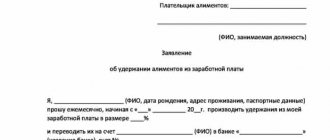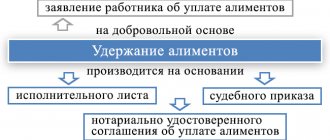Last modified: June 2020
You can pay alimony in different ways: transfer it to the recipient's current account, send the payment by postal order, or hand over the money personally. If the payer decides to resort to the latter method, the fact of transfer of funds must be documented. In the future, the recipient of the maintenance will not be able to say that alimony payments were not accrued to him. In this article we will consider whether a receipt for receipt of alimony can be appropriate evidence, when it is needed and how to draw it up correctly.
Receipt for alimony - what is it for?
The document will protect both parties from possible legal disputes in the future. Citizens often have questions about its legal force, form, content, and procedure for filling it out.
To answer them, you need to understand what it is, what requirements the jurisprudence imposes on a receipt for alimony.
This is a legal document confirming (certifying) the fact of transfer by one party, the payer, the ex-spouse - the father of the child, of funds to the other, the recipient - the mother, as part of his fulfillment of obligations to pay child support.
The purpose is legal certification (recording) of the funds transferred by the father for the maintenance and satisfaction of the needs of a minor son or daughter after a divorce. Why is it important to record this fact in this case?
Breach of trust
In life, good relations between people are not always maintained after the termination of marriage.
Often contacts between ex-husband and wife are hostile. This is confirmed by examples of divorces of public figures and representatives of show business.
Based on the desire to “spoil” the ex-wife, in the future there may be a desire to review, challenge or additionally collect the alimony debt through the court.
In such a situation, the plaintiff will not always act decently towards his opponent.
Inflicted grievances, and sometimes the division of property, during a previous family life together, often outweigh common sense and push the commission of such actions.
Most often, going to court to obtain a penalty for alimony when monthly payments are made is a woman’s reaction in order to take revenge on her ex-husband for the grievances caused.
Expert commentary
Roslyakov Oleg Vladimirovich
Lawyer, specialization civil law. More than 19 years of experience.
Ask a question
From a legal point of view, it is unlawful to file for collection if payments have been made in full. Another thing is when child support is not paid by a man at all, or not in full - then the woman has the right to obtain it through the court.
Possible consequences
The simplest method, which would provide grounds for review or collection of additional (often illegal) payments, is to appeal to the judicial authorities regarding non-payment of alimony.
However, you should expect to win the case in court only if the money was transferred from hand to hand without selecting a document certifying the completion of this action.
If there is no supporting written evidence, then the ex-wife, by filing a claim in court, has a chance to oblige the child’s father to pay a penalty for alimony that was actually received earlier.
However, no matter what arguments are given by the defendant, the main argument confirming the actions taken will be a receipt for the transfer of funds. If it is not there, the court can most often support the plaintiff’s arguments.
If the ex-husband has not fulfilled (or partially fulfilled) his alimony obligations, i.e., has evaded paying them, in this case it is necessary to go to court to collect a penalty by filing a statement of claim.
You can draw it up by contacting a lawyer through the form on the website, where there are samples of claims for this type of court case
What are the possible difficulties and abuses?
Difficulties can arise if the legal procedure is neglected.
For example, a father pays child support to his ex-wife, but does not take a receipt at all indicating that she received the money. He relies on the honesty of his ex-wife.
The mother can abuse her rights and file a lawsuit against the child's father. The lawsuit will demand recovery of the debt and penalties for late payment. The father has nothing to confirm the fact of conscientious fulfillment of the obligation. The court will accept the complaint as justified and make a decision to collect the debt. Then, with the help of a bailiff, the plaintiff will be able to legally collect the debt.
In addition, if the receipt is written on a computer, printed and only signed by the parties, it may serve as a reason to refuse to sign in court. Since one signature is sometimes not enough to take handwriting for analysis by graphological examination.
It is important to know that as of October 1, 2019, the magistrate’s court considers in writ proceedings only cases for the collection of alimony in shares of earnings. Cases regarding late payments and collection of penalties are now within the jurisdiction of the courts.
Legal force
This concept in the scientific literature is understood as the ability of a document to bear legal consequences and be the subject of legal actions. The main condition for a receipt to have legal force is its correct drafting.
Russian legislation does not require it to be notarized. It has legal force if all mandatory requirements are met, and will be valid when presented to judicial or other government authorities.
It is sufficient to comply with all the necessary conditions, which include the correct reflection of complete and reliable information about the participants in the legal relationship.
Note! If the child’s father has decided to pay a child support debt or, say, a large sum towards his obligation in advance, then it is recommended to notarize this fact.
As mentioned above, if one of the parties wants to collect alimony debt, the presence of a correctly executed receipt will confirm the payments made to the recipient.
In what cases is a receipt for alimony required?
To know when it is necessary to draw up a receipt, you need to understand how payment of alimony obligations occurs.
The Family Code of Russia provides for the following types::
- the procedure for payments based on an agreement on the payment of alimony;
- voluntary payment procedure without concluding an agreement between parents;
- based on a court decision.
Each method of fulfilling an obligation provides for the option of recording the receipt of money. In all cases, this document acts as a guarantee of the action. Its shape is also the same everywhere.
Under an agreement to pay alimony
In this option, funds are transferred on the basis of an alimony agreement concluded between the parties, certified by a notary.
According to it, one of the participants transfers a fixed amount from his income to the recipient within a specified time frame, to a bank account, credit card, or hands it over personally.
When the alimony payer is employed in a government or commercial organization, he can submit an application and a copy of the agreement to his employer or the financial department, with a request to deduct from him a monthly agreed amount (specified in the contract) and transfer it to the bank account of the child’s mother.
This is the most practical and legally safe option for the payer. According to the law, financial statements are evidence of fulfillment of obligations.
If, by mutual agreement, the option is chosen in which the money is transferred directly to the recipient, drawing up a receipt for alimony in this situation is mandatory.
By court decision or court order
Often, former spouses do not come to mutual agreement on the issue of calculating alimony payments, then the procedure for collecting them through the court is applied.
With this procedure, the child’s mother submits a claim for a court order for alimony (you can find a sample of it on our website in the appropriate section), which, after consideration, determines the amount depending on the number of children, their state of health and other facts of interest.
Note! In accordance with Art. 81 of the RF IC for one child, the amount of payments is 25% of all statutory income of the debtor. If there are two or more children, the amount is from one third of all income.
Judicially appointed alimony, if the ex-husband officially works, can be transferred to the recipient’s account through a deduction from wages or other payments.
However, here too the option of selecting a receipt is possible if the money is transferred to the ex-wife. In this situation, the specified document will be confirmation of fulfilled obligations.
Voluntarily
In practice, sometimes there are cases when trust between an ex-husband and wife has been preserved, and the relationship has not developed into hostility.
In this situation, people jointly decide on the amount and timing of alimony payments without filing a claim in court or drawing up a legal agreement. The conditions and procedure are regulated by them.
At the same time, we recommend that you still formalize the transfer of money to the child in writing.
It cannot be ruled out that the relationship between once close people will change, and the ex-wife will want to reconsider or recover a large amount for the child - she has the right to file a lawsuit.
That’s when receipts for alimony payments will come in handy; without them, it will be difficult to prove payments.
Features of the document
A receipt for payment of alimony is a fairly simple, but extremely important document that confirms the fact that one of the parents successfully pays alimony in favor of the child. Its main feature and huge advantage is that the registration procedure is simple to the point of impossibility. The agreement is drawn up in free written form and secured by the signatures of the parties.
In order for this document to acquire legal force, it is by no means necessary to have it certified by a notary. Of course, parents have every right to certify the certificate, but it is recommended to contact a notary only if the amount of payments is especially large.
Also, to give the receipt legal force, the presence of witnesses is not required; in case of non-compliance with the conditions and violation of the child’s right to alimony, a forensic examination will be carried out. Thus, to formalize the agreement, only the consent of both parties and written confirmation of their will is sufficient.
The concluded agreement will allow you to receive alimony payments in a fixed amount directly into your hands. This document serves as an excellent method for regulating alimony legal relations.
How to correctly write a receipt for alimony
How to write a receipt for alimony sample:
Receipt for alimony, completed form
In order to correctly draw up a receipt for alimony, a number of necessary requirements must be met.:
- Have the consent of the recipient of material benefits to write it.
- Maintain its shape.
- Compose by hand, although it is possible to write it on a typewriter or using computer technology. A handwritten document is easier to identify through forensic examination.
- Handwriting and text must be legible.
- Be sure to write down who, to whom, and for what the alimony was paid.
- The amounts indicated therein should be written first in numbers and then in words.
- The text must be written or printed legibly to avoid discrepancies.
- There should be no spelling or punctuation errors.
- At the end of the receipt for alimony, they write that I have no complaints.
Compliance with these rules will protect the payer from proving that he fulfilled his duties in good faith in the event that a claim is filed against him for the collection of a penalty or revision of alimony.
Forensic examination, when a document is correctly drawn up, recognizes it as authentic.
Form of receipt for alimony
Russian law provides for a simple written form for this document without mandatory notarization.
This form is intended to be complete and valid if completed correctly and all conditions are met.
The law does not require notarization of any receipts for receipt of funds (including this one). The only way a notary can help is to make a mark on it that the document is genuine.
Content
The receipt for child support must contain the necessary details. Without any of them, it is called into question and will be declared invalid.
It must necessarily indicate:
- Name.
- Complete installation data for both sides.
- The purpose of the transfer of funds is payment of alimony, within the framework of which it is carried out (indicate the number of the agreement, court decision).
- The amount is written first in numbers and then duplicated in words.
- The currency in which the payment is made.
- For what period, time (for one or several months).
- Full name, year and day of birth of the child.
- Time and place of compilation.
- Signatures of both parties. After the signature, it must be decrypted.
- Witness information, if any.
Receipts for alimony, in accordance with the law, are drawn up in 2 (two) copies. One copy remains with each of the parties. It is advisable to save them all until the child reaches his 18th birthday.
Kinds
Based on practice, three types can be distinguished. The division occurs depending on the link to the legal decision governing the payment of alimony.
There are the following types:
- The usual option. When a document is drawn up without being bound to any agreement.
- With reference (indication) to the legal act within the framework of which this action is carried out.
- On official letterhead. It is filled out when the amount of payments is determined as part of a court decision.
Binding when drawing up a legal act will increase its legitimacy. In the event of legal disputes, fewer questions will arise for the payer.
The sample receipt for child support presented on our portal meets all of the above requirements.
Do I need a notary or witnesses?
When drawing up a receipt, in order for it to obtain the status of a document and legal significance, the presence of two people is sufficient: its compiler - the recipient of alimony, and the person transferring it - the payer. The very fact of writing a text about receiving funds and securing it with your signature already becomes confirmation of the action of transferring money.
Both parties sign on the document (receipt). If a witness is present, his signature is also placed on the document.
The payer of alimony transfers the funds to the recipient, and he writes a receipt about this and gives it to the payer. It is advisable to draw it up in two copies so that each party has it.
Notarization of the receipt is not required. The presence of third parties - witnesses - during its preparation is also not necessary.
At the same time, the law does not prohibit certifying a receipt by a notary or indicating in it one or two witnesses to the transfer of funds. This entirely depends on the desire and degree of trust of the parties. Sometimes the party transferring funds wants to take advantage of such insurance so that this fact has additional confirmation.
It would be advisable to seek the help of a notary when it comes to a one-time transfer of alimony in a very large sum of money. This situation is possible, for example, if alimony is paid by an individual entrepreneur and at some time his profit has increased significantly.








